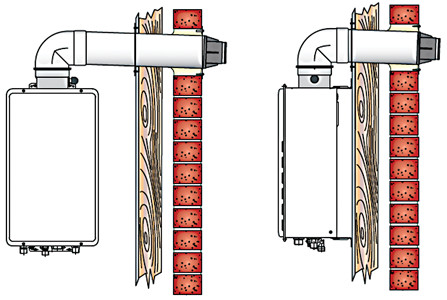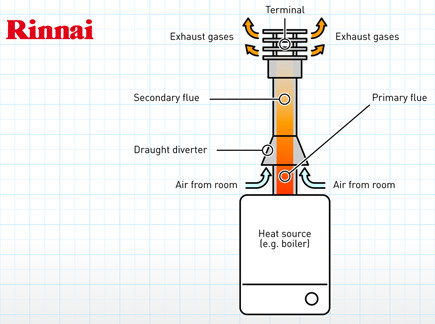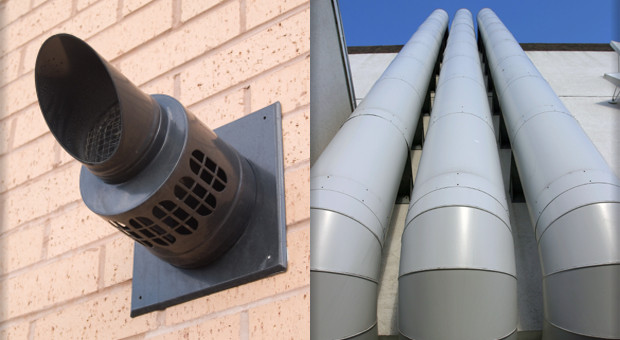Can I mount my water unit internally or externally.
What is a flue?
A flue is a pipe, a duct or a chimney for exhausting combustion gases from a fireplace, water heater or boiler to the outdoors.
Combustion gases contain carbon monoxide and other dangerous compounds, therefore proper 'draught' and induction of replacement air is imperative.
Flue Types
The different types of flue can be described as open (conventional) flues and closed flues. Closed flues are better known as balanced flues or fanned flues and are used with room sealed units.

Open Flues
Open flued appliances draw combustion air from its surroundings. It is vitally important that suitable ventilation is provided to the space containing the appliance. This will ensure air can enter the space from outside.
Regulation will specify what needs to be provided in each application.
An open flue usually incorporates a draught diverter near the base. The flue will consist of a 'primary flue' which is the section from the appliance heat exchanger to the draught diverter. After the draught diverter will be the secondary flue.
Most appliances incorporate draught diverters; therefore, the primary flue will only be a relatively short length of flue between the heat exchanger and the draught diverter.
The draught diverter will provide an 'air gap' between the appliance and the secondary flue. This is very important as the 'pull' or suction created by the secondary flue will depend upon flue height and configuration, albeit the appliance will need to operate within its design specification which is provided by the built in components including the primary flue.
As its name suggests, an important function of the draught diverter is to allow the occasional down draught without disturbing combustion within the appliance.
This natural draught created by the draught diverter and secondary flue will pull in additional air as well as the products of combustion (exhaust gases) from the appliance. This pull can be tested by using a simple smoke test.
The secondary open flue typically continues vertically, with some lateral deviations allowable, to terminate at a suitable external point. The flue can run internally, externally or within an existing chimney (using a suitable flue liner). The greater the vertical height the greater the pull, however, the pull will be reduced depending upon the amount of lateral deviations added.


Balanced Flues
All room sealed appliances will have a balanced (fanned) flue. It will include an air duct to bring combustion air into the appliance. No air is taken from the space containing the appliance. Room sealed appliances are intrinsically safe as products of combustion will not normally escape into the occupied space.
As the balanced flue terminal has the flue outlet and inlet in close proximity, any draughts or gusts of wind will cancel out in the appliance, thus burner flames are not affected.
Because balanced flues are only powered by natural draught, they must be kept quite short. Usually, they need only be long enough to pass through and external wall against which the appliance is installed.
Fanned Flue
Fanned flues utilise a fan to power the movement of outside air into the appliance and combustion products to external air.
This will allow much bigger lengths of flue ducts for both combustion air and exhaust air of smaller diameter and allow the inclusion of several changes of direction.
In most cases, fanned flues are concentric, meaning the combustion air duct contains the exhaust duct within it. Longer runs of ductwork are possible where an individual two pipe arrangement is used to run combustion air and exhaust air separately.
Some fanned flues are also open flues, whereby taking air from the space housing the appliance. As with all open flues, the provision of adequate ventilation to supply combustion air is very important.
